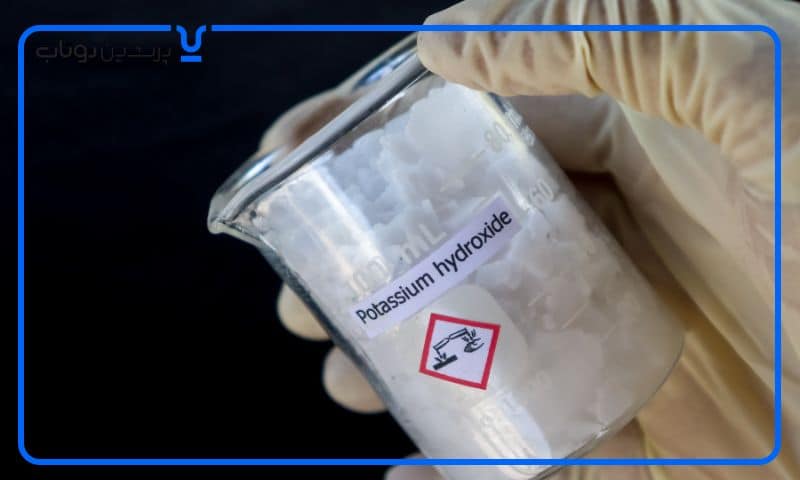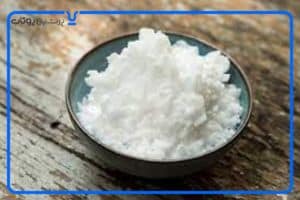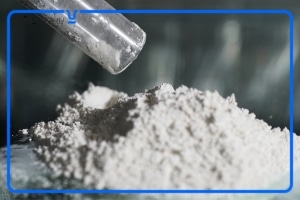قدم به قدم تا شناخت كامل هيدروكسيد پتاسيم
قدم به قدم تا شناخت كامل هيدروكسيد پتاسيم
قدم به قدم تا شناخت كامل هيدروكسيد پتاسيم با ما همراه باشید. در ابتدا با این ماده آشنا می شویم. هیدروکسید پتاسیم یک ترکیب قلیایی معدنی قوی با فرمول شیمیایی KOH است. غیر قابل احتراق، آب دوست است و بنابراین برای فلز و بافت بسیار خورنده است. به راحتی رطوبت جو را جذب کرده و یک محلول سوزاننده تشکیل می دهد که به آلومینیوم و روی حمله می کند. هیدروکسید پتاسیم به عنوان پتاس کاستیک یا لیس نیز شناخته می شود. پیش ماده سایر ترکیبات پتاسیم است. بسیار محلول در آب و محلول آزاد در اتانول است. وقتی در آب یا الکل حل می شود یا وقتی محلول با اسید تیمار می شود، گرمای زیادی تولید می شود. به صورت جامد خشک (90-92٪ هیدروکسید پتاسیم) و به عنوان محلول (45-50٪ هیدروکسید پتاسیم) به بازار عرضه می شود. از روش های مختلفی می توان هیدروکسید پتاسیم تولید کرد. در گذشته از خاکستر چوب تولید می شد، اما امروزه توسط الکترولیز کلرید پتاسیم به صورت صنعتی تولید می شود . در حالت جامد حدود 90-95٪ هیدروکسید پتاسیم (پتاس کاستیک) با تبخیر محلول هیدروکسید پتاسیم بدست می آید. در ادامه قدم به قدم تا شناخت کامل هیدروکسید پتاسیم به سراغ کاربردهای این ماده می رویم.
کاربردهای درمانی هیدروکسید پتاسیم
قدم به قدم تا شناخت كامل هيدروكسيد پتاسيم ! در پزشکی، از هیدروکسید پتاسیم (KOH) در تشخیص هیپ های قارچی یا تریکومونادها استفاده می شود. به عنوان نرم کننده شیارهای ناخن نیز استفاده می شود. این ماده یک قلیایی قوی است که از مدت ها قبل برای هضم پروتئین ها، لیپیدها و بیشتر بقایای اپیتلیال خراش های پوست برای شناسایی عفونت های قارچی شناخته شده است. هیدروکسید پتاسیم یک ماده سوزاننده قوی است که برای از بین بردن زگیل استفاده می شود.

در داروسازی
خوردگی هیدروکسید پتاسیم آن را به ماده ای بسیار مفید در تجزیه، از بین بردن بافت نرم و از بین بردن مو تبدیل می کند. این ماده در برخی از محصولات ناخن، کرم های اصلاح و صابون ها گنجانده شده است.
ادامه کاربردهای پتاسیم هیدروکسید
در ساخت صابون مایع، پاک کننده های چاپ و لاک، آبکاری، حکاکی عکس و لیتوگرافی، جوهر چاپ، در شیمی تحلیلی برای تیتراسیون آلکالیمتری، ماده الکترولیت در باتری های ذخیره قلیایی و برخی سلول های سوختی، جاذب دی اکسید کربن و سولفید هیدروژن، مواد رنگی، کودهای مایع، مواد افزودنی خوراکی، علف کش ها، آبکاری، ذوب سازی، مواد پاک کننده رنگ، مواد سفید کننده، مواد شیمیایی بهداشتی مواد غذایی و آشامیدنی، مایعات عملکردی (سیستم های باز)، در تولید و پالایش نفت، ضد یخ، مصالح ساختمانی و…استفاده می شود. باید با احتیاط نگهداری و مصرف شود در غیر اینصورت، باعث سوختگی شدید چشم، پوست و غشاهای مخاطی می شود. در ادامه قدم به قدم تا شناخت کامل هیدروکسید پتاسیم به سراغ خطرات محیطی این ماده می رویم.
خطرات آتش سوزی
این ماده غیر قابل احتراق، خود نمی سوزد، اما ممکن است هنگام گرم شدن تجزیه شود و بخارات خورنده یا سمی تولید کند. برخی از آنها اکسید کننده هستند و ممکن است مواد قابل احتراق (چوب، کاغذ، روغن، لباس و غیره) را مشتعل کنند. تماس با فلزات ممکن است گاز هیدروژن قابل اشتعال را تکامل دهد. ظروف ممکن است هنگام گرم شدن منفجر شوند.
پتانسیل آتش سوزی
هنگام خیس شدن، به فلزاتی مانند آلومینیوم، قلع، سرب و روی حمله کرده و گاز هیدروژن قابل اشتعال تولید می کند .
اشتعال پذیری
جامد غیر قابل احتراق با این حال، ممکن است با H واکنش نشان دهد.
روش های دفع
هر قسمت مواد استفاده نشده را برای استفاده مصوب از آن بازیافت کنید یا آن را به تولید کننده یا تأمین کننده برگردانید. برای دفع نهایی ماده شیمیایی باید در نظر داشته باشید که این ماده بر کیفیت هوا تاثیر می گذارد. باعث آلودگی خاک و آب و تاثیر بر زندگی حیوانات، آبزیان و گیاهان می شود.
خنثی سازی
پتاسیم هیدروکسید را با احتیاط در آب حل شده و با اسید استیک رقیق خنثی می شود.
اقدامات پیشگیرانه
پتاسیم هیدروکسید پردازش بیشتر مواد جامد ممکن است منجر به تشکیل گرد و غبار قابل احتراق شود. قبل از پردازش اضافی باید پتانسیل تشکیل گرد و غبار قابل احتراق را در نظر گرفت. از تماس با پوست و چشم ها جلوگیری کنید. از تشکیل گرد و غبار و آئروسل ها خودداری کنید. تهویه مناسب اگزوز را در مکان هایی که گرد و غبار تشکیل شده فراهم کنید.
ذخیره سازی امن
از مواد غذایی و خوراکی، اسیدهای قوی و فلزات جدا نگه داشته شود. فقط در ظرف اصلی و خشک نگهداری شود. باقیمانده های هیدروکسید پتاسیم در صورت استفاده مطابق با رویه خوب کشاورزی به عنوان مواد بی اثر (یا بعضاً فعال) در فرمولاسیون سموم، برای محصولات در حال رشد یا کالاهای خام کشاورزی پس از برداشت استفاده می شود.




